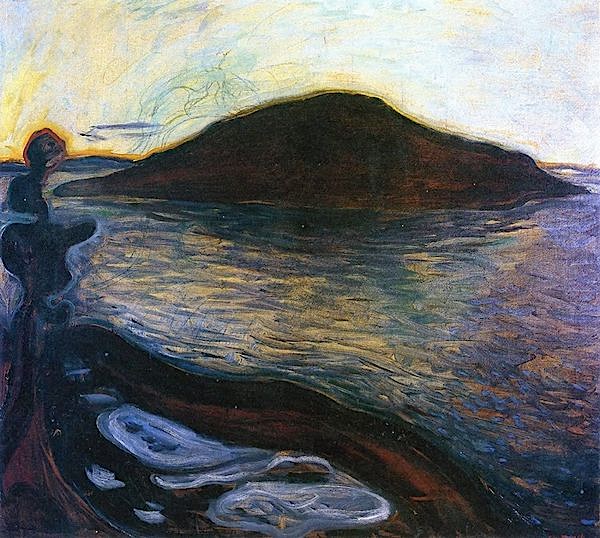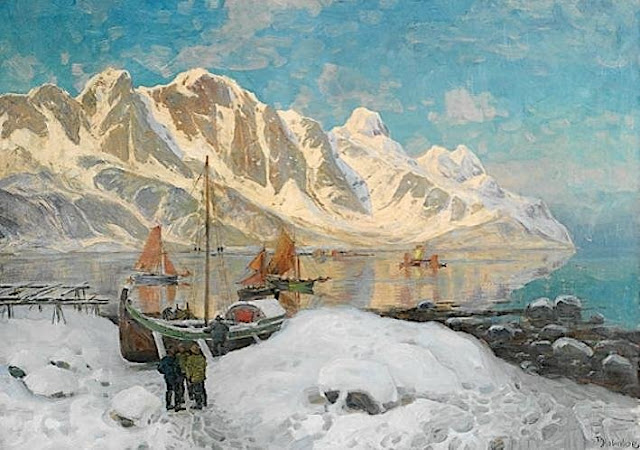Johan Christian Dahl (Norwegian, 1788–1857)
Sognefjord (1000m)
Norvège
In Winter at the Sognefjord (February 1827) Huile sur toile, 75.5 x 61.5 cm. Nasjonalgalleriet, Oslo
Le Fjord
Le
Sognefjord (plus de 1000 mètres) Sognefjorden en norvégien, est un
fjord situé au nord de Bergen, en Norvège. Le Sognefjord est le fjord le
plus long d'Europe et le deuxième plus long du monde après le Scoresby
Sund au Groenland ; il s'agit également du fjord le plus large de
Norvège. Situé dans le comté de Sogn og Fjordane dans l'ouest de la
Norvège, il s'enfonce dans les terres sur 204 kilomètres, jusqu'à la
ville de Skjolden. Sa profondeur atteint 1 308 mètres en dessous du
niveau de la mer. Les profondeurs maximales sont atteintes un peu à
l'intérieur des terres : près de son embouchure, le fond du fjord monte
de façon abrupte jusqu'à un plateau situé à 100 m en dessous du niveau
de la mer. La largeur moyenne du Sognefjord est d'environ 4,5 km. Des
falaises le surplombent jusqu'à des hauteurs supérieures à 1 000 m.
Parmi les villes situées sur le fjord et ses bras, on peut citer
Balestrand, Gudvangen et Flåm. La beauté du fjord en fait une
destination touristique très prisée. De nombreuses croisières sont
possibles sur le Sognefjord, été comme hiver. Une ligne touristique de
chemin de fer, la ligne de Flåm, longe le Sognefjord.
Le peintre
Johan Christian Dahl (ou J. C. Dahl) est un peintre paysagiste norvégien. issu d'un milieu simple : son père étant un pêcheur modeste de Bergen, en Norvège. Enfant, Dahl étudie à la cathédrale de Bergen pour devenir prêtre, mais ses capacités artistique précoces l'amènent à tenter une carrière dans la peinture. De 1803 à 1809, il étudie avec le peintre Johan Georg Müller , dont l'atelier est alors le plus important de Bergen. Il se met à travailler la peinture pour des décors de théâtre, s'essaie à l'art du portrait et des vues de Bergen et de ses environs. Dahl poursuit ses études à l'Académie de Copenhague, ville dont il peint la campagne environnante. En 1812, il écrit à Lyder Sagen, l'un de ses mentors, que Jacob van Ruisdael et Caesar van Everdingen sont parmi les paysagistes qu'il a le plus imités.
Dahl participe à des expositions d'art annuelles à Copenhague à partir de 1812, mais sa vraie percée se produit en 1815, quand il expose pas moins de treize tableaux. Le prince danois Christian Frederik veille à ce que ses œuvres soit achetées pour la collection royale ; il devient aussi un ami et un mécène de l'artiste. En 1816, Dahl rencontre C.W. Eckersberg et devient son ami. Après son succès à Copenhague, Dahl devient un artiste indépendant. Toutefois, ses préférences académiques demeurent attachées aux peintures historiques véhiculant des messages moraux, ainsi qu'aux paysages pourtant considérés comme un art bas et, dans certains milieux, même pas comme de l'art du tout mais comme une imitation purement mécanique de la nature. Les seuls paysages pouvant être considérés comme de l'art, selon l'Académie, sont des idéaux, des paysages imaginaires dans les styles pastoral ou héroïque. Conformément à ce goût régnant alors, Dahl tente de donner à ses thèmes danois un certain caractère atmosphérique afin de les élever au-dessus de ce qui est alors considéré comme un niveau artistique purement commercial. En même temps, il conserve intact son désir le plus profond de donner une image plus fidèle de la nature norvégienne. Cette volonté reste en partie motivée par la nostalgie et le patriotisme, mais il s'agit également d'une marque d'adaptation de la sensibilité de l'artiste au goût du public. En septembre 1818, Dahl se rend à Dresde. Il y rencontre Caspar David Friedrich qui l'aide à s'y établir et devient un ami proche. Un critique écrit : « Friedrich produit alors des paysages minutieusement exécutés - exemples d'un art informé par son éducation protestante stricte et d'une recherche de la volonté divine dans la nature - qui ont été à juste titre célèbres au moment où il fait la connaissance de Dahl. De cette période, nous sommes en mesure de voir ses Deux hommes contemplant la lune (1819) ; tout comme le tableau Greifswald au clair de lune (1816-1817) qui dépeint la ville natale de l'artiste, en Poméranie, sur la côte de la Baltique: baignant dans un même clair de lune. » De Dresde, Dahl voyage à la campagne pour rechercher des sujets qui pourraient lui être utiles dans les grands travaux qui seraient peints plus tard dans son atelier. Il écrit au prince Christian Frederik en 1818 que « la plupart du temps, [il] représente la nature dans toute sa liberté et sa sauvagerie ». Dahl a assez de matière dans la région de Dresde pour fournir des motifs pour ses peintures, mais il continue à peindre des paysages imaginaires de forêts, de montagnes et de cascades. Par exemple, une peinture intitulée Norsk fjellandskap med elv (Montagnes du paysage norvégien avec un fleuve), achevée en 1819, suscite une grande attention parmi les jeunes artistes. Une autre peinture, représentant une monumentale chute d'eau, est achevée en 1820. La même année, Dahl est accepté à l'Académie de Dresde. Le prince Christian Frederik écrit à Dahl en 1820 depuis l'Italie et l'invite à le rejoindre sur le golfe de Naples. Il y passe finalement dix mois. Ce séjour devient un facteur décisif de son développement artistique. C'est en Italie, avec sa forte lumière méridionale, que l'art de Dahl atteint véritablement son apogée.
Dahl est à Rome en février 1821. Il passe beaucoup de temps à visiter les musées, rencontre des artistes et peint. Parmi les sujets que lui inspire l'Italie, il peint le site de Rome et le golfe de Naples. En tant que membre de l'académie, Dahl consacre toujours une partie de son temps à la formation de jeunes artistes. En 1824, Caspar David Friedrich le nomme professeur extraordinaire, ce qui lui permet de recevoir un salaire régulier. Parmi ses élèves, figurent Knud Baade, Peder Balke et Thomas Fearnley. Avec son épouse, Dahl vit à Dresde à partir de 1823. En 1827, Emilie Dahl meurt quand elle accouche de leur quatrième enfant. En 1829, leur second enfant meurt de la scarlatine. En janvier 1830, Dahl épouse son élève Amalie von Bassewitz, mais elle aussi meurt en couches en décembre de la même année. Quelques années plus tard, son plus jeune enfant meurt, laissant Dahl avec deux enfants survivants, Caroline et Siegwald. Bien que vivant à Dresde, il multiplie les voyages en Norvège, où il se rend en 1826, 1834, 1839, 1844 et 1850, la plupart du temps pour peindre les montagnes. Lors de son dernier voyage en Norvège en 1850, il se découvre vieillissant et très affaibli, bien qu'il s'astreint à continuer de peindre des paysages dans les montagnes. Ce dernier voyage dans son pays natal est toutefois l'occasion pour lui de réaliser plusieurs de ses œuvres parmi les plus saisissantes.
_________________________________________
2023 - Wandering Vertexes ....
Errant au-dessus des Sommets Silencieux...
Un blog de Francis Rousseau
,%20The%20Seven%20Sisters%20Mountain%20Range%20(c%201845-50),%20(2000M-%206500%20ft%20Norway)%20oil%20on%20panel,%2025%20x%2031%20cm,%20Private%20collection.%20The%20Athenaeum..jpeg)

%20%20Winter%20at%20the%20Sognefjord%20(February%201827)%20Oil%20on%20canvas,%2075.5%20x%2061.5%20cm.%20Nasjonalgalleriet,%20Oslo.jpg)
%20%22The%20Moon%20in%20May%22-%20ca.1908%20Color%20woodcut%20with%20hand%20coloring%20on%20paper,%207%201:2%20x%2010%20in.%20(19%20x%2025.4%20cm.)%20Private%20collection-%20Mt%20Grovanipa..jpg)
%20%20Northern%20Lights.%20Study%20from%20North%20Norway%20(c.%201901-09)%20Oil%20on%20canvas,%2046%20x%2055%20cm.%20%20Nationalmuseum,%20Stockholm.jpg)
%20%20Sandnoesoen,%20Norv%20,%201925,%20watercolor,.png)
















